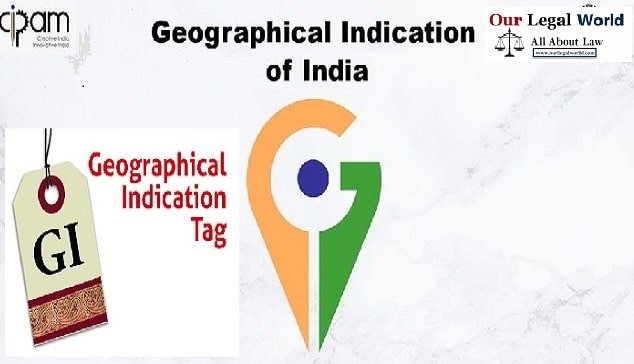Geographical Indications in India
GI tag is the abbreviation of Geographical Indications.The concept of GI tag came into force with effect from 15th September 2003. Darjeeling Tea was the first product in India which got a GI tag. The Geographical Indications of Goods (Registration & Protection) Act, 1999 came into effect from September 2003 and after that the registration of GIs began in the financial year 2004-05. GI tags are issued by the Geographical Indication Registry under the Department of Industry Promotion and Internal Trade, Ministry of Commerce and Industry.Until now around 365 products have been added to the GI list.
What is a GI Tag?
A geographical indication is basically a sign which is used on the products that have a specific geographical origin and possess origin based qualities and have reputation in that region. Geographical Indication is granted to agricultural, natural, manufactured, handicraft originating from a definite geographical territory or a place and then it becomes an unique identification for that specific product and increases its value.
The characteristics, qualities, and popularity of the product should be essentially due to the place of origin of the product. The Tag of Geographical Indication is regarded as a certification for a product which certifies that the particular product is produced as per traditional methods and has certain specific qualities, or has a particular reputation because of its geographical origin and unique features.
Article 22 of the TRIPS (Trade-Related Aspects of Intellectual Property Rights) Agreements defines Geographical Indication as “indications which identify a good as originating in the territory of a Member, or a region or locality in that territory, where a given quality, reputation or other characteristic of the good is essentially attributable to its geographical origin“.
The first GI tag in India was registered in 2004, after that 301 GI’s have been granted Registration as on October 25, 2017 by the GI Registry, India. The GI Registry has received 610 GI Applications as on January 11, 2018. Out of the GIs that are registered until now, 64 per cent are related to handicrafts, 26 per cent are for agricultural products, 6.18 percent are for manufactured products and the remaining are for foodstuff and textile products.
Geographical Indications of Goods (Registration and Protection) Act, 1999
Before enactment of this act, there was no separate legislation for GIs for India. However, there existed three alternative ways in which the existing legal systems of the country of that time could be utilised for preventing the misuse of GIs:
(i) Consumer protection laws
(ii) through passing off legal action in courts; and
(iii) through certification trademarks.
The definition of GI tag under this act is “Geographical Indications refers to an indication which identifies goods as agricultural, natural or manufactured goods (including handicrafts, textiles and processed food items) as originating, or manufactured in a definite geographical territory, where a given quality, reputation or other characteristic of such goods is essentially attributable to its geographical origin; in case of manufactured goods, one of the activities of either production or processing or preparation takes place in such territory, region or locality”.
Under this Act, if a producer applies for a GI for a manufactured good, he must make sure that at least one of the activities of either the processing or production or preparation of the product must take place in the Indian territory. If seen in this sense, the GI Act is more restrictive than the TRIPs definition followed around the world.
The Department for Promotion of Industry and Internal Trade (DPIIT) has taken several initiatives for promotion and marketing of GIs including this act. In order to increase the income of the GI producers i.e. farmers, weavers, artisans and craftsmen, a comprehensive and holistic campaign on promotion of GIs has been undertaken by the department and the government.
Also Read: Arbitration and Conciliation Act, 1996 : Power and Function of Arbitration
Benefits of Registration in India
The Geographical Indication registration confers the following benefits:
1.Promotes economic prosperity to producers by enhancing their demand in national and international markets.
2.It enables seeking legal protection in other WTO(World Trade Organisation) member countries
3.Provides legal protection to geographical indications in India..
4.It boosted exports of Indian geographical indications by providing them legal protection.
5.It enables the right holders to use the indication to prevent its use by a third party whose product does not belong to the particular region and doesn’t have the required quality and standards.
6.GI Tag ensures that no one other than authorized users are allowed to use the popular product name.
7.It helps consumers to get quality products of desired features and authenticate the products.
Registration of GI is not compulsory in India. However if registered, it will afford better legal protection to facilitate an action for infringement.
GI tag can be applied for:
- Inventions (Patent)
- Trademark (Goods and Services)
- Industrial Designs
- Geographical Indications
- Writings
- Musical works
- Dramatic works
- Audiovisual works
- Paintings and drawings
- Sculptures
- Photographic works
- Architectural works
- Sound recordings
- Performance of musicians, actors & singers
- Broadcasts
How to apply for Geographical Indication in India?
- Any association of persons, producers, organization established under the law can apply for GI Tag.
- The applicant must act as a representative of the interest of the producers.
- The application must be prescribed form and in writing.
- The application should be addressed to the Registrar of Geographical Indications along with the fixed fee.
The Registration of a Geographical Indication can be done for a period of ten years at once. But Renewal is possible for further periods of 10 years each by filing an application.
The Common GI Logo and Tagline
Each GI can have a different logo,but this will lead to confusion in consumers about various GI products. Therefore,a new idea of a common GI Logo and Tagline was introduced. A common GI tag would help create awareness amongst the producers and consumers which will ultimately increase the marketability and saleability of these products. This initiative will also help in engaging more people and make them aware about the concept of GI’s.
DPIIT(Department for Promotion of Industry and Internal Trade) had conducted a public contest for the logo and tagline for Geographical Indications of India. The selected logo and tagline for Indian products registered as Geographical Indications were launched on 1st August, 2018.The Department for Promotion of Industry and Internal Trade under the Ministry of Commerce and Industry in June 2019 released a notification stating the guidelines of the common GI logo and tagline on all GIs of India.These guidelines are being issued for the maximum usage of the GI logo and tagline, and thereby helps in promotion of Indian GI products.
The logo consists of a ‘G’ and ‘I’ and has the three colours of the Indian flag. The tagline in English is ‘Invaluable Treasures of Incredible India’ (अतुल्यभारतकीअमूल्यनिधि)
Foreign GI products are not permitted to use this logo.This logo helps consumers across the globe to identify the authentic GI products of India. It also immensely helps in promotion and marketing of Indian products. GI Logo and Tagline shall not be used for illegal purposes or for anything against public interest.They shall not be used in a derogatory fashion.
How many geographical indications are there in India?
The products of India which got GI tag until now are those products with the origin’s claim to fame but they had also attracted the consumers from different parts of the globe because of their distinctive features. From Kashmir Pashmina to Kerala’s Aranmula Kannadi, Mizo Chilli to Makrana Marble of Rajasthan, there are hundreds of such unique products registered in India holding the (GI) tag.
Around 65 GI’s of Indian origin have already been registered with the GI Registry These include GI like Darjeeling (tea), Pochampalli, Ikat (textiles), Chanderi (sarees), Kancheepuram silk (textiles), Kashmir Pashmina (shawls), Kondapalli (toys), and Mysore (agarbattis).
Products from various foreign countries have also been registered in India.There are 15 products in the register until now whose origin is another country but are still registered under GI Tag in Indian directory. These products are registered in India to ensure the recognition and protection. These products are mainly wines and spirits. A total of nine countries i.e UK, USA, Ireland, France, Italy, Mexico, Thailand, Peru and Portugal have their registered products in India directory.
Disputes related to GI Tag
Some disputes arose between different states to register a particular product on their name.For example, the disputes surrounding the origin of Roshogulla, a popular dessert, from eastern India. Both West Bengal and Odisha claim that the dessert originated in their own states. By ‘winning’ a GI tag, each state is trying to promote its own culture over the other state
This sort of competition tends to polarize the country on regional, cultural and linguistic lines. As a result of this dispute,neither the local community nor the customer is benefiting economically. This trend undercuts the very idea of GI protection to native endemic products.The tag for geographical indications should only be allotted after a thorough historical and empirical inquiry.
One solution to resolve this dispute can be that for products whose origin can’t be effectively traced, either both the states should be given ownership or none of the regions be provided with the GI tag.The focus of the states and the community needs to shift from mere certification and instead divert all resources towards active promotion of the product and its respective industry.
However, a protected GI does not allow the holder of the tag for that product to forbid someone from making a product using the same approaches as set out in the standards for that indication. Protection for a GI tag is usually procured by acquiring a right over the sign that constitutes the indication which also gives rise to many disputes.
Geographical Indications Protection
Geographical indications are protected and preserved in various countries and regional systems through a wide way of approaches:
There are three ways in which a geographical indication can be protected:
- By initiating Special regimes of protection
- Using collective or certification marks for each product
- Focusing on techniques concentrating on business practices.
These approaches have been developed keeping in mind different legal practices and within a framework of an individual’s historical and economic conditions.
Legal protection of GI assumes enormous significance keeping in consideration its commercial potential.Without suitable legal protection, the competitors who do not have any legitimate rights on the GI might ride free on its reputation. Such unfair business practices result in the loss of revenue for the genuine right-holders and also sometimes mislead consumers to buy defective products instead of original.
Conclusion
Geographical Indications is the most emerging field of Intellectual property. Every region has its claim to fame and it should get the opportunity to keep it protected. Geographical Indications of Goods are that aspect of industrial property which refers to the geographical indication referring to a country or to a place situated as being the country or place of origin of that particular product.
The GI tag conveys an assurance of quality,distinctiveness and uniqueness which is specifically attributable to the fact of its origin in that defined geographical locality, region or country.The recognition and protection of these products allow the producers’ community to devote and maintain the precise qualities of the product on which the reputation is built.
This also allows them to invest together in promoting the reputation of the product.Geographical indications are regarded as strong tools for protecting their national property rights. Some critics however, consider GI as a barrier to trade.
References
- https://www.mondaq.com/india/trademark/688456/protection-of-geographical-indications
- https://www.ipindia.nic.in/writereaddata/Portal/News/536_1_GI_Guideline__Finalised_..pdf
- https://www.jagranjosh.com/general-knowledge/list-of-geographical-indications-gi-tags-in-india-1589464565-
- https://factly.in/how-many-geographical-indications-are-registered-in-india
- https://byjus.com/free-ias-prep/geographical-indication-tags-in-india/
- https://iprlawindia.org/wp-content/uploads/2020/02/2019-GI-Statistics-.pdf
- https://www.wipo.int/geo_indications/en/https://www.indiatoday.in/education-today/gk-current-affairs/story/odisha-s-rasagola-to-goa-s-khola-chilli-list-of-gi-tags-2019-divd-1628927-2019-12-17
- https://www.altacit.com/publication/the-protection-of-geographical-indication-in-india/
Edited By- Ankita Roy








![Tax Law Internship at Legum Attorney [Chamber of Ashish Panday], Delhi : Apply by 15th May 2025](https://www.ourlegalworld.com/wp-content/uploads/2025/05/IMG_0113-min.png)

